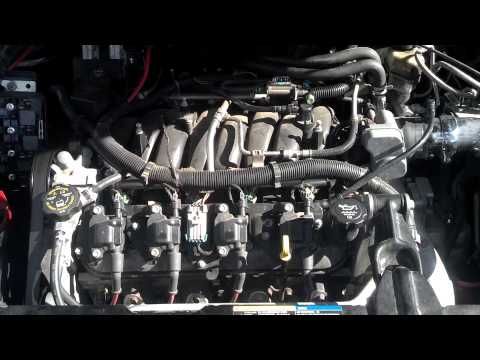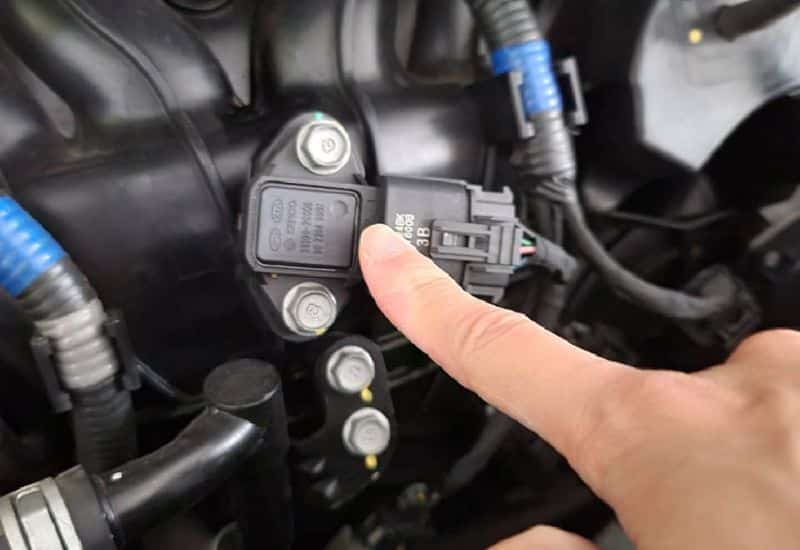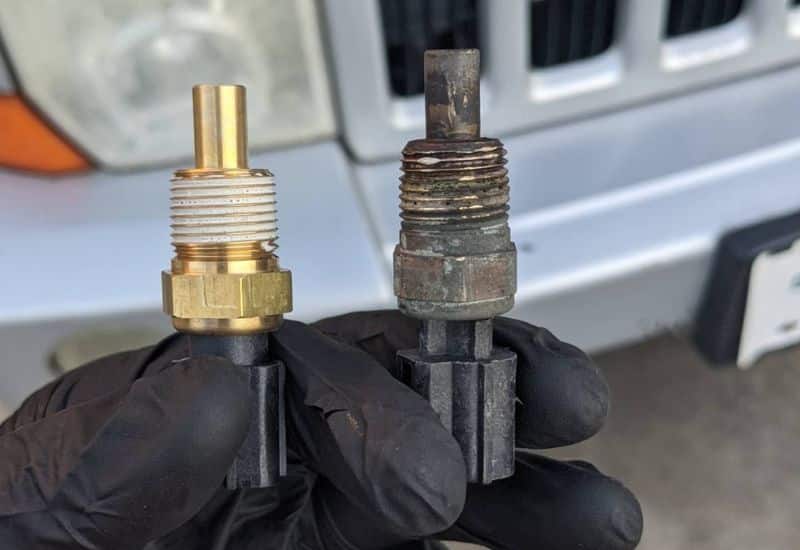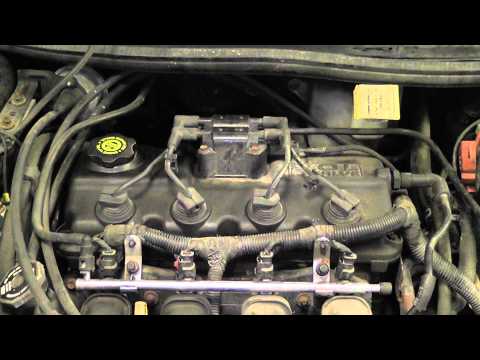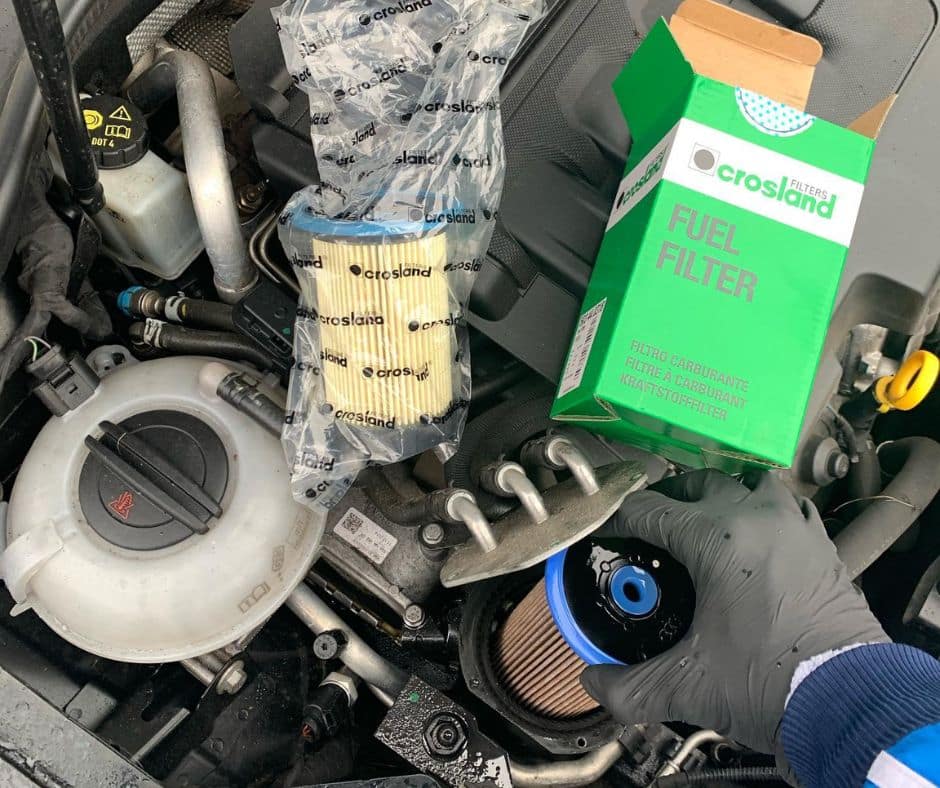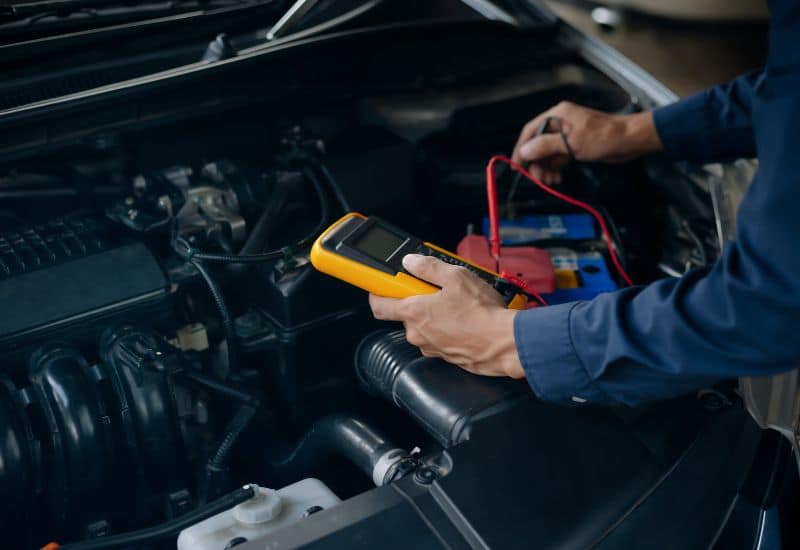
Imagine you’re cruising down the road, enjoying the drive, and suddenly your car starts to shake and jerk. You feel a loss of power and acceleration, and the engine doesn’t sound right. These are signs that something’s not right under the hood – you might be experiencing an engine misfire.
But what exactly happens when your car’s engine misfires?
An engine misfire occurs when one or more combustion cycles are skipped, which leads to power loss, increased emissions, and the possibility of engine and exhaust system damage. The causes of misfires can vary; for example, ignition coils may fail to provide the necessary spark to ignite the fuel in the combustion chamber, while dirty or worn spark plugs reduce the spark’s ability to jump the gap. Additionally, leaks in the vacuum system can cause the engine to run lean, resulting in misfires.
What your engine misfire feels like depends on what’s causing it, and it can happen at any point and without warning, not just when you turn your engine on.
Fixing an engine misfire is crucial to prevent further damage, and ignoring even a single engine misfire could lead to an exhaust system and engine issues. Therefore, it’s
essential to address engine misfires as soon as possible.
To help you identify the symptoms of a misfiring engine, determine what’s causing your car engine to misfire, and learn how to fix it, we’ll take a short tour through the internal combustion process and all the factors that affect the normal engine performance.
What is an Engine Misfire?
Engine misfires occur when unburned fuel lingers in the combustion chamber of one or more cylinders. Often the cylinder doesn’t fire and/or fires out of sequence. It can also cause deposits of unburned fuel to migrate into the exhaust system, causing other problems.
What Does An Engine Misfire Sound Like?
Engine misfires often sound like a popping, knocking, or banging noise coming from inside the engine bay. In some larger engines, it might sound like a thud or a thump. It usually happens in concert with a shuttering feeling and the car being immediately down on power.
What Does An Engine Misfire Feel Like?
If your engine misfires, you’ll likely feel a shaking, stumbling, or jerking sensation as you accelerate. Your engine may even hesitate momentarily or lose power briefly.
While your car idles, you can notice the engine vibrating more than usual and running unevenly. I can still remember a time when two of my cylinders misfired at once, causing my car to feel like it was driving over rumble strips.
In most misfires, you might not only feel a jerking motion but also hear popping sounds, bangs, or ongoing soft thuds coming from the engine. These symptoms often lead to the check engine light turning on or flashing, signaling that something is amiss under the hood.
How Do I Know Whether My Engine is Misfiring?

The most common signs of engine misfiring include shaking, stuttering during acceleration and jerking at low and idle speeds, accompanied by bangs and popping sounds in the engine bay. If the misfiring problem is bad, the check engine light might come on or flash.
Dangerous misfires often cause symptoms like:
1. Check Engine Light Will Illuminate
The check engine light often comes on when an engine misfires due to the ECU reading faults detected by a variety of sensors. Sometimes the check engine light will come on and stay on, and sometimes it will flash during the misfire event and then turn itself off.
Different vehicles have different thresholds for what constitutes a check engine light. So even if your check engine light flashed during a misfire event and turned off, don’t assume that the problem has completely gone away.
A misfire that causes a check engine light is often related to a failure in one or more ignition coils and/or fouled spark plugs. However, other things could be the root cause of the misfire.
Diagnosis of Common Engine Misfire Codes
Diagnosing the codes from a check engine light caused by a misfire will speed up troubleshooting.
Some of the more common misfire codes show up as P0301 to P0308. Here the P03 indicates a misfire or fault in the cylinder, and the number following it is the exact cylinder. So a four-cylinder engine will only have P0301 through P0304.
You might also see the following:
2. Jerking or Rough Acceleration
When the engine is under load, jerking and rough acceleration problems caused by misfires tend to worsen. Particularly coil-over-plug ignition coils. This causes a sudden jerk, shuttering, or rough acceleration. This type of misfire usually strikes at the worst possible time, such as when you’re accelerating hard to get up to highway speed or setting off towing a heavy trailer.
Though you might also notice misfire performance issues when you’re slowing accelerating over a longer period of time. Especially if the engine has been running hot.
Sometimes, you can have one or more cylinders that aren’t firing properly, causing the engine to be unbalanced and leading to severe vibration when accelerating or idling.
3. The Engine Has Been Idling Rough
A rough idle can also be a sign of an engine misfire or a problem in the engine that will soon cause a serious misfire. This rough idle is often due to minor fuel/air ratio deviations caused by sensor problems, compression issues, or a minor leak in the intake manifold gasket.
In smaller engines, a minor misfire problem localized in a single cylinder can be mistaken for a rough idle. Though if it happens frequently, your exhaust will have a fuel or oil odor from the small volume of unburned fuel passing through the exhaust system. I had a hot hatchback in the mid-1990s that did this without ever throwing a check engine light!
A lot of the problems that cause engine misfires and rough idling will lead to stalling at the lights or an idle that runs high or low, seemingly at random.
4. The Engine Is Making a Tapping or Knocking Sound
Engine misfires often cause tapping or knocking sounds that recur in cadence with the missing cylinder. When one of the cylinders isn’t firing due to a dead ignition coil, bad spark plug, or other fuel system fault, the sound of the engine can change.
Sometimes you’ll even hear a tapping or knocking sound that is off-cadence from how the engine normally sounds. This might mean a misfire happens in a single cylinder with every cycle. It also means that a small volume of unburned fuel is moving around in your engine, depositing in your exhaust system where it can wreak havoc.
What Causes Your Car’s Engine to Misfire?
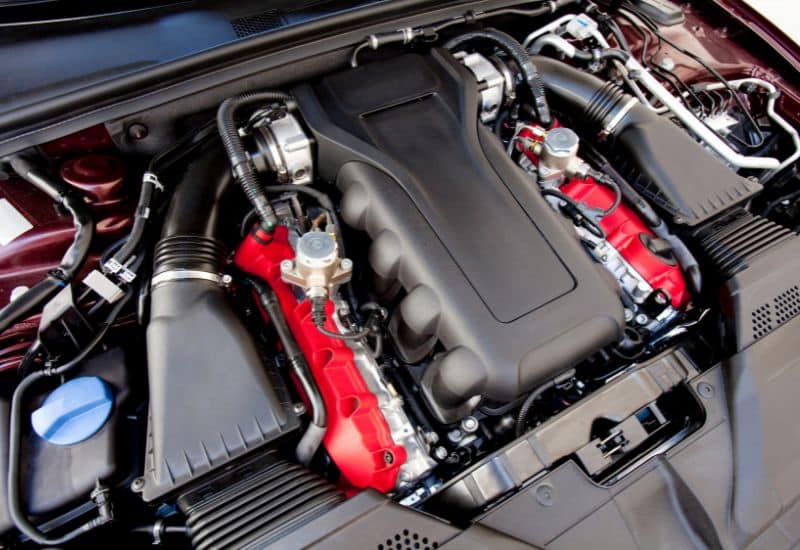
The most common causes of an engine misfiring include bad spark plugs, failing ignition coils, and fuel injector problems just to name a few. This can be related to one or more of the following problems occurring at the same time.
1. Bad or Fouled Spark Plugs
Bad or fouled spark plugs caused by carbon deposits or blistered by overheating might not fire consistently. This can leave unburned fuel in the cylinders that misfire out of sequence or fail to fire. It can also allow excess unburned fuel to invade the exhaust system, where it can cause damage to the catalytic converter and other critical components.
It a well-maintained engine spark plugs that will last as much as 75,000 to 100,000 miles. At this point, they’ll need to be replaced, and you’ll need a high mileage tune-up. If you’re over this mileage, then there’s a good chance bad spark plugs are part of the reason why your car is misfiring while accelerating.
Though even if your car is under 75,000 miles, there’s still a chance that your spark plugs have been fouled by carbon deposits, blistering, or oil residue. Especially if you’ve been lax about routine maintenance or your car has been running hot.
2. An Ignition Coil Problem or Distributor Cap
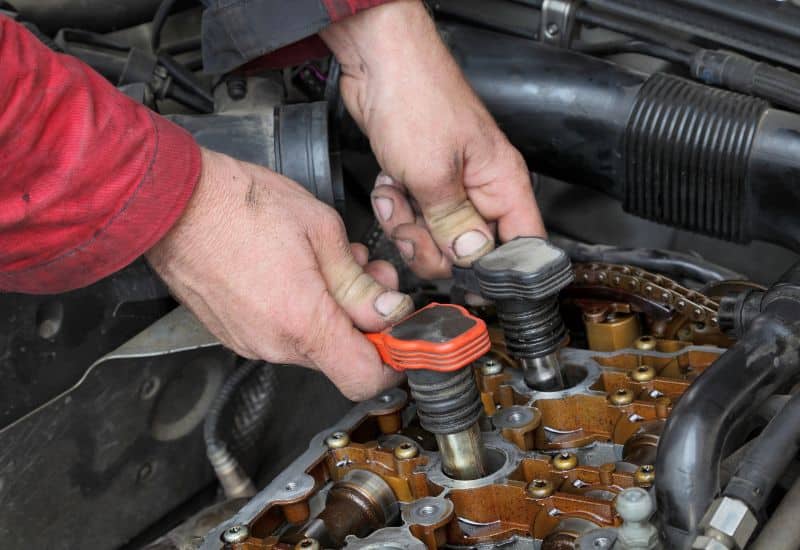
An ignition coil problem or a faulty distributor cap can cause a misfire or a failure of the sparkplug to fire. When this happens, the coil fires out of sequence or does not fire on time. This affects the plugs’ spark, leading to a misfire.
This is more common in engines that suffer from excess wear and tear. Ignition coil misfires can also come from running the engine hot all the time, which can degrade the insulation between the secondary coil windings and the primary ignition coil.
When an ignition coil goes out, it can be very hard to tell if the problem is the coil or the spark plugs. Though usually, when a coil goes, the related spark plug fouls. You end up replacing both as long as you’re there.
Technically, Ignition coils are supposed to last up to 100,000 miles or more. This is true in cars that don’t have an overheating issue. In my truck, that’s asked to do a lot of towing and sometimes runs hot when it’s under load for hours, the average lifespan seems to be around 60,000 to 70,000 miles at best.
3. Poor Fuel Pressure
Misfires can be caused by low fuel pressure due to a fuel filter clog or a fuel pump failure. This causes a minuscule amount of fuel to enter the combustion chamber, leading to a lean fuel/air mixture and misfires on multiple cylinders.
In many of these cases, a clogged fuel filter is the root cause of low fuel pressure. A clogged filter can result in low pressure, though it can also cause problems with the fuel pump or the fuel pressure regulator.
If you haven’t had your fuel filter replaced in the last 30,000 to 40,000 miles and you’re experiencing misfire events on multiple cylinders at a time, you should be highly suspicious of a fuel system problem.
If you can safely get to an auto parts store, you can buy a manual fuel pressure gauge. This will let you test the pressure in your fuel system to either confirm or eliminate it as the cause of your engine misfire.
4. A Fuel Injector Problem
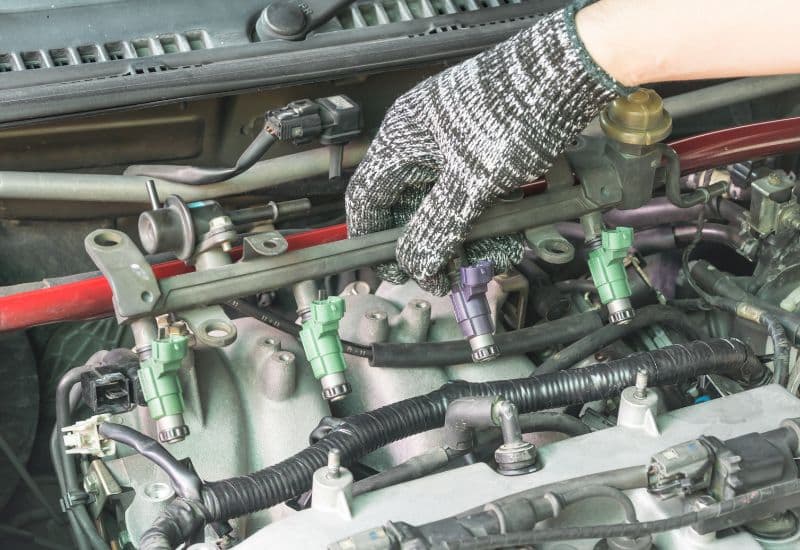
Misfires can occur when one or more fuel injectors are clogged to the point that they can’t deliver the precise volume of fuel to the dedicated cylinder. This causes the engine to run either too rich or too lean, causing each affected cylinder in the engine to misfire.
Failed injectors aren’t very common on most modern car models, and because of this, you’ll want to check out the other possible causes first, but it’s definitely worth checking if you can’t find the issue.
Technically, fuel injectors have a long lifespan of 50,000 to 100,000 miles. However, they can easily be fouled if debris or contaminants pass through your car’s fuel system. If you have a partially clogged fuel filter, or you have a bad habit of running the engine down to the fuel warning light all the time, it can foul the injectors, shortening their life.
5. Compression Problems
Misfires caused by compression problems can be linked to a failed seal, valve problems, or some other type of unknown compression leak. When this happens, the air ratio in the fuel/air mixture is off, causing multiple cylinders to misfire.
The good news is you can usually get a decent compression tester for under $25. This will help you figure out where the compression problem is and what needs to be fixed or replaced.
6. A Gasket Failure in the Intake Manifold
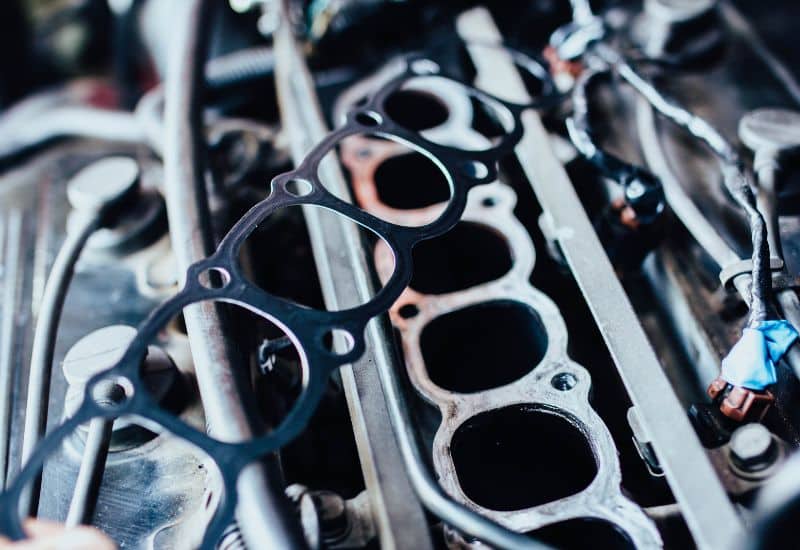
A failure in the intake manifold gasket can also cause your car engine to misfire as it lets excess air into the combustion chamber, causing an imbalance in the fuel/air mixture. There are also a variety of vacuum lines that could also have a leak.
This problem can be frustrating to diagnose as you feel like you’re chasing gremlins around the engine bay. However, a failure in the intake manifold is more likely to cause serious engine misfires.
If your engine runs hot or overheats, you’re also at higher risk of misfiring from an air intake manifold issue. This severe heat can accelerate the eventual failure of the intake manifold gasket.
7. Sensor Failures
Failures in the oxygen sensors, the MAF sensor, the MAP sensor, or the coolant temperature sensor are common causes of engine misfires. However, each of these sensors plays a different role that you have to account for when troubleshooting.
I. A Faulty MAP Sensor
The Manifold Absolute Pressure (MAP) sensor in the engine provides the ECU with instant manifold pressure information. The ECU relies on this data to accurately calculate the ambient air density as well as determine the engine’s air mass flow rate. This affects the volume of fuel supplied, creating a fuel/air mixture perfect for sustainable internal combustion.
If a faulty MAP sensor indicates a false high-pressure reading, the ECU will automatically signal for more fuel. This rich mixture can foul spark plugs and cause an engine misfire.
Codes indicating a bad MAP sensor can be:
II. A Faulty MAF Sensor
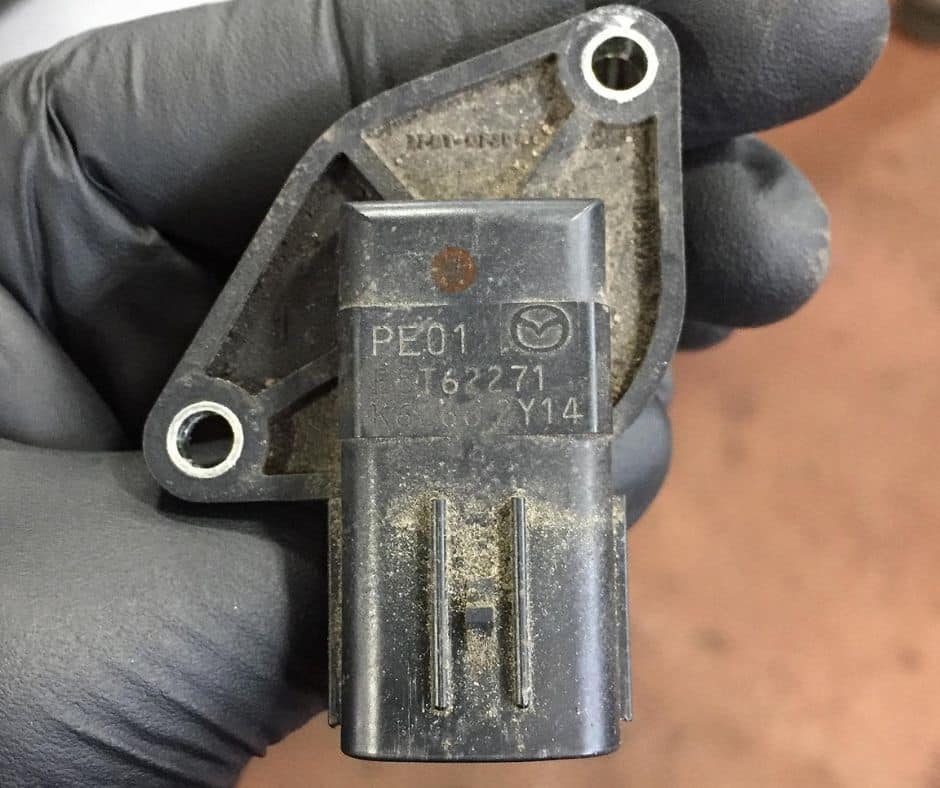
A Mass Air Flow (MAF)sensor is responsible for the important job of accurately measuring the amount of air entering the engine. If there’s a fault in the MAF sensor, it will register an available air mass that is too low. This then causes the engine to inject too little fuel resulting in an overly lean mixture which could cause an engine misfire.
It’s also possible for a MAF sensor problem to measure an overly high air mass. This causes too much fuel to be injected, resulting in a rich fuel/air mixture causing a misfire.
The code for a bad MAF sensor is P0101
III. A Faulty Oxygen Sensor
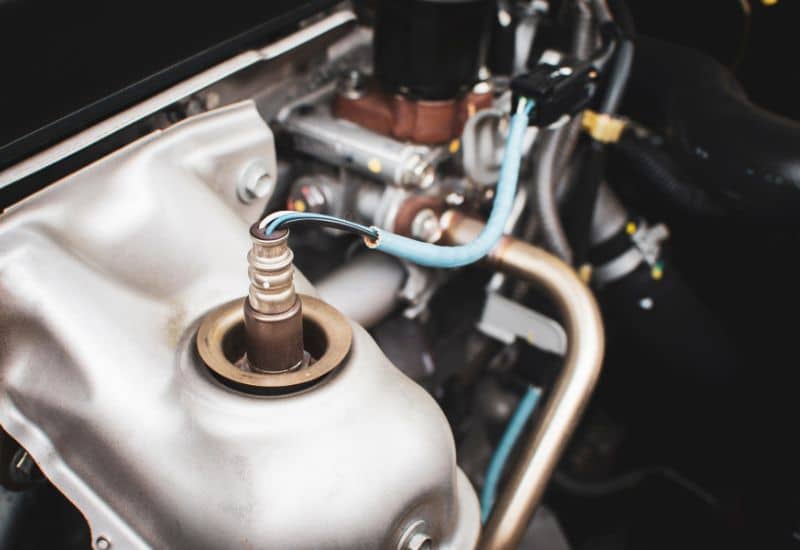
Oxygen (O2) sensors are responsible for measuring the volume of unburned oxygen in the exhaust and immediately send this information to the ECU. The internal computer then adjusts the fuel/air ratio for what should be optimal engine performance.
When an oxygen sensor fails or starts to fail, it sends incorrect data to the ECU. The fuel/air ratio is then off, increasing the misfire risk.
The code for a bad oxygen sensor is usually P0138
IV. A Coolant Temperature Sensor Failure
Engine misfires can sometimes be caused by coolant temperature sensor failures which confuse your ECU. Basically, the false temperature reading causes your ECU to adapt the injection time and firing angle to what it thinks the current operating conditions are. This causes the engine to run either too rich or too lean, leading to a misfire.
It’s also possible for a bad coolant temperature sensor and an undiagnosed coolant system problem to cause the engine to run overly hot or severely overheat. When this happens, you’re at risk of fouling the spark plugs as well as the intake manifold gasket. Both of which can also cause an engine misfire.
The code for a bad coolant temperature sensor is P0118.
How to Fix an Engine Misfire
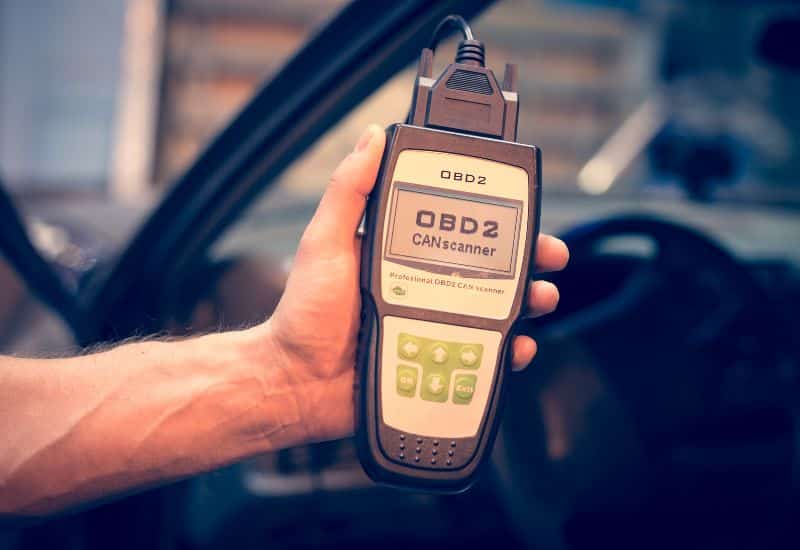
Fixing an engine misfire starts with checking all the codes. A code reader will be able to help you determine if there’s a coil, spark plug, or sensor problem. You can also use a compressor test kit to check for compression issues. An OBD II code reader will be able to tell you which cylinders the misfire occurred on.
Fixing a Misfired Caused by a Bad Ignition Coil or Spark Plug
A misfire caused by an ignition coil or coil pack going out usually ends up also causing a spark plug problem. Though it’s hard to tell if the cause of the engine misfire is the coil or the spark plug, they both act very similarly.
You can confirm which one the culprit is by separating the ignition coil from the suspect spark plug. Then move the suspect spark plug and ignition coil to different cylinders. At that point, you clear the codes and take the car for a test drive knowing full well that it’s going to misfire at some point.
You head back nice and slow when it does and hook the code reader up again. If it throws a code for a different cylinder, you’ll be able to determine if it was the spark plug or the ignition coil.
Usually, when you need to replace a bad ignition coil, it only makes sense to spend a few extra minutes replacing a potentially foiled spark plug with a fresh new one. This gives you some added peace of mind while only adding an extra $25 or so to the repair cost.
Fixing an Engine Misfire Caused by an Air Leak
Fixing an engine misfire caused by an air leak is supposed to be easy, but I’ve had times when I felt like I was chasing gremlins. The bush fix diagnostic that seems to work best here is to start the engine and let it run until it’s idling normally.
Then spray a little bit of carb cleaner or starting fluid around the engine where you suspect a leak. If there’s an air leak, it will suck some of this mildly flammable aerosol fluid in, which will cause the engine to cycle a little faster.
This is one of those things that can be frustrating if you do it too fast. So go slow and steady, use a small amount and be wise enough to keep a fire extinguisher nearby. Once you find the air leak, you’ll have to complete the correct repair to get the fuel/air mixture back to a controlled ratio.
Repairing an Engine Compression Problem
Repairing a misfire caused by a compression problem can be an expensive fix. A compression tester will give you a good idea of where the compression problem is. Once you’ve narrowed it down, you’ll have to inspect the suspect engine components.
This includes the valves, piston rings, and timing belts. Any one of which can be a seriously costly repair. This might be beyond what a home mechanic can do, but at least you’ll be better informed about the problem if you need to take it to a professional mechanic to handle the repair.
Fixing an Engine Misfire Caused by a Fuel System Problem
The first step in fixing a misfire caused by a fuel system problem is to replace the fuel filter. It needs to be done anyway if it’s already been over 30,000 miles since you last had it replaced. This will also help you diagnose other fuel system parts should the misfire persist.
Once you’ve replaced the old fuel filter, you can test the fuel system pressure with an electronic or manual tester. Hooking the manual tester up to the fuel rail will give you the most reliable result. You can then compare the reading to the manufacturer’s specs.
If it’s too low and you’ve already replaced the fuel filter, you likely need to replace the fuel pump. If the fuel pressure reading is too high, then you might need to replace the fuel regulator.
Fixing an Engine Misfire Caused by Bad Sensors
Fixing an engine misfire caused by a bad sensor is usually as straightforward as installing a new replacement. Then you just need to clear the codes with the code reader.
Just be prepared for one sensor to be bad, you replace it, and a few weeks later, another one goes. They often seem to have a similar lifespan.
Frequently Asked Questions
Is It Safe to Drive with a Misfiring Engine?
You might be able to get away with driving a misfiring engine for a few days, but the consequences you risk are very high and prohibitively expensive. Misfires can cause serious damage to critical components deep down in the engine.
Not to mention the very high likelihood of unburned fuel getting into the exhaust system, causing even more expensive damage. Even if the catalytic converter makes it through, you might still fail an emissions test if your state requires them.
How Much Does It Cost to Have a Mechanic Fix a Misfiring Engine
A cheap fix, such as a loose vacuum hose, a clogged fuel filter, or a single-fouled spark plug, might only cost you $200 or less. This can go up quickly to $350 or more if you have multiple bad ignition coils and fouled spark plugs.
When you start tangling with compression problems and a failing fuel pump, the cost to have a professional mechanic handle the repair can go up to $500 or more. This type of repair, especially the fuel pump, is something better left to the professionals.
How Can I Tell If a Misfire Has Damaged My Exhaust System
If you live in a state requiring emissions tests, and your car previously passed one, but it fails the emissions test after the misfire incident, you’re also looking at yet another major repair. A damaged catalytic converter can also cause:
Conclusion
Even a seemingly small misfire problem can be a major problem. Attempting to drive on it puts your engine and your exhaust system at major risk from the uncontrolled combustion of unburned fuel. So, it’s wise to pull over as soon as possible to troubleshoot the issue.
A lot of times, it’s either a spark plug and/or an ignition coil problem. Though you shouldn’t rule out some type of air leak in the intake. These repairs are the sort of thing that you can probably fix on your own for less than $200. However, a mechanic might charge you more.
If the engine misfire is caused by a fuel system issue, you might get lucky with the cheap replacement of a clogged fuel filter. Though if you’re dealing with low or high fuel pressure after the filter change, a more expensive fuel pump or fuel regulator might be to blame.
The worst-case scenario is the engine misfire, caused by a serious compression issue. A cheap compression tester will help you dial in where it is. Though problems with valves and rings might be beyond what you can repair yourself, and you might end up with a mechanic’s bill over $500.

Written By
Jason Farrell
Jason Farrell is a certified master technician, the editor of Mechanic’s Diary in Pittsburgh, Pennsylvania. He is ASE (Automotive Service Excellence) certified and earned a Bachelor’s Degree in Automotive Technology from Pittsburg State University. With nearly 18 prior years of experience in the automotive field, he has extensive knowledge about Domestic, European, and other foreign makes and models of cars and light trucks. Jason’s experience working as a technician and service manager at dealerships, gave him the experience and know-how of most aspects of inspection, diagnosis, and repair from engine and drivability to electrical, HVAC, brakes, steering and suspension and everything in between.

